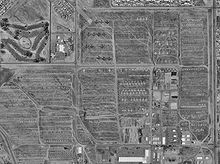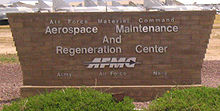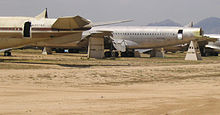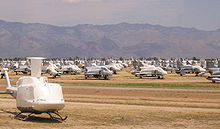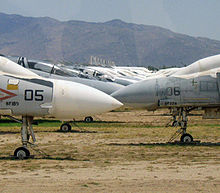- 309th Aerospace Maintenance and Regeneration Group
-
309th Aerospace Maintenance and Regeneration Group 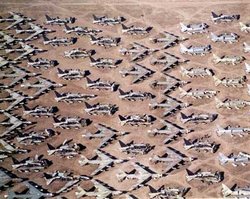
Active 1946 – present Country United States Branch Air Force Type Group Role Equipment Support Part of Air Force Materiel Command Garrison/HQ Davis-Monthan Air Force Base Commanders Current
commanderColonel Patrick T Kumashiro The 309th Aerospace Maintenance and Regeneration Group (AMARG),[1] often called The Boneyard, is a United States Air Force aircraft and missile storage and maintenance facility in Tucson, Arizona, located on Davis-Monthan Air Force Base. AMARG was previously Aerospace Maintenance and Regeneration Center, AMARC, the Military Aircraft Storage and Disposal Center, MASDC, and started life after World War II as the 3040th Aircraft Storage Group.
AMARG takes care of more than 4,400 aircraft, which would make it the second largest air force in the world. An Air Force Materiel Command unit, the group is under the command of the 309th Maintenance Wing at Hill Air Force Base, Utah. AMARG was originally meant to store excess Department of Defense and Coast Guard aircraft, but has in recent years been designated the sole repository of out-of-service aircraft from all branches of the US government.
Contents
History
AMARG was established in 1946[2] as the 4105th Army Air Force Unit to house B-29 and C-47 aircraft. Davis-Monthan Air Force Base was chosen because of Tucson's low humidity, infrequent rainfall, alkaline soil and high altitude of 2,550 feet (780 m), reducing rust and corrosion.[3][4] The hard soil makes it possible to move aircraft around without having to pave the storage areas.
In 1948, after the Air Force's creation as a separate service, the unit was renamed the 3040th Aircraft Storage Depot. In 1965, the depot was renamed the Military Aircraft Storage and Disposition Center (MASDC), and tasked with processing aircraft for all the US armed forces (not just the Air Force). The U.S. Navy had operated its own boneyard at Naval Air Station Litchfield Park at Goodyear, Arizona for Navy, Marine and Coast Guard aircraft. In February 1965 some 500 aircraft were moved from Litchfield Park to Davis-Monthan AFB. NAS Litchfield Park was finally closed in 1968.[5]
In the 1980s, the center began processing ICBMs for dismantling or reuse in satellite launches, and was renamed the Aerospace Maintenance and Regeneration Center (AMARC) to reflect the expanded focus on all aerospace assets.[6]
In the 1990s, in accordance with the START I treaty, the center was tasked with eliminating 365 B-52 bombers.[7] The progress of this task was to be verified by Russia via satellite and first-person inspection at the facility. Initially, the B-52s were chopped into pieces with a 13,000-pound guillotine winched by a steel cable, supported by a crane.[8] Later on, the tool of choice became K-12 rescue saws. This more precise technique afforded AMARG with salvageable spare parts.
In May 2007, command of AMARC was transferred to the 309th Maintenance Wing, and the center was renamed the 309th Aerospace Maintenance and Regeneration Group.[1]
Storage procedures
There are four categories of storage for planes at AMARG:
- Long Term – Aircraft are kept intact for future use
- Parts Reclamation – Aircraft are kept, picked apart and used for spare parts
- Flying Hold – Aircraft are kept intact for shorter stays than Long Term
- Excess of DoD needs – Aircraft are sold off whole or in parts
AMARG employs 550 people, almost all civilians. The 2,600 acres (11 km2) facility is adjacent to the base. For every $1 the federal government spends operating the facility, it saves or produces $11 from harvesting spare parts and selling off inventory.[9] Congressional oversight determines what equipment may be sold to which customer.
An aircraft going into storage undergoes the following treatments:
- All guns, ejection seat charges, or classified hardware are removed.
- The fuel system is protected by draining it, refilling it with lightweight oil, and then draining it again. This leaves a protective oil film.
- The aircraft is sealed from dust, sunlight, and high temperatures. This is done using a variety of materials, ranging from a high tech vinyl plastic compound, called spraylat after its producer the Spraylat Corporation, of a opaque white colour sprayed on the aircraft, to simple garbage bags. The plane is then towed by a jeep to its designated "storage" position.
The Group annually in-processes an undisclosed number of aircraft for storage and out-processes a number of aircraft for return to the active service, either repainted and sold to friendly foreign governments, recycled as target or remotely controlled drones[10] or rebuilt as civilian cargo, transport, and/or utility planes.[11] For instance, Turkey has purchased several Vietnam-era jets in recent years that had been stored on site. There is much scrutiny over who (civilians, companies, foreign governments) and what kind of parts they may buy. At times, these sales are canceled, the Air Force for example reclaimed several F-16's from AMARG for the Strike Fighter Tactics Instructor Courses which were originally meant to be sold to Pakistan, but never delivered due to an early-90's embargo.
Accessibility
AMARG is controlled-access site, and is off-limits to anyone not employed there without the proper clearance. The only access for non-cleared individuals is via a bus tour which is conducted by the nearby Pima Air & Space Museum. Bus tours are Monday though Friday only.[12]
Use in movies and TV
AMARC has also been site of filming for scenes in several movie and television productions, despite the rather heavy security of AMARG and the base in general. The most recent and notable of these is Transformers: Revenge of the Fallen. The exterior scenes of the Smithsonian set were actually filmed in the Boneyard. The background of several shots can be clearly recognized while looking toward the fence-line from one of the major streets that run along the perimeter.[13] Other works include the 1991 movie Harley Davidson and the Marlboro Man; the music video for Tom Petty and the Heartbreakers' song "Learning To Fly"; and various other productions, including a brief shot in Baraka.[14]
See also
References
- ^ a b Official 309th AMRG Renaming Ceremony.
- ^ USAF AMARC Fact Sheet.
- ^ Hanbury Evans Newill Vlattas and Company (January 1998). "Design Compatibility Standards Davis – Monthan Air Force Base Tucson, Arizona". U.S. Army Corps of Engineers. http://www.spa.usace.army.mil/ec/DMAFBDG.pdf. Retrieved 28 December 2009.
- ^ Napolitano, J. (December 2004, revised May 2005). "Arizona’s Military Installations: Ready for the Transformation of the Department of Defense". azgovernor.gov. http://www.azgovernor.gov/mft/documents/051305~MilitaryInstallationMay2005~Updated.pdf. Retrieved 26 December 2009.
- ^ U.S. Navy Naval Aviation News July 1966, pp. 18 [1]
- ^ AMARC Experience Story.
- ^ "START Treaty". U.S. Department of State. 31 July 1991. http://www.state.gov/documents/organization/27361.pdf. Retrieved 28 December 2009.
- ^ Norris, R.S. (1995). "Nuclear Notebook". Bulletin of the Atomic Scientists 51 (1): 69. http://books.google.com/books?id=twwAAAAAMBAJ&pg=PA69&dq=russian+satellite+davis+monthan+air+base+observation&cd=1#v=onepage&q=russian%20satellite%20davis%20monthan%20air%20base%20observation&f=false. Accessed 28 December 2009.
- ^ Aerospace Maintenance and Regeneration Group, Davis-Monthan Air Force Base (official website).
- ^ Tucker, Tom (2000). The eclipse project – Monographs in aerospace history #23 – NASA history series. Washington: U.S. Government Printing Office. p. 10. http://www.nasa.gov/centers/dryden/pdf/88791main_Eclipse.pdf. Retrieved 28 December 2009.
- ^ "A Memorial for Aerial Reconnaissance". The Communicator V (32). 1991. http://www.nsa.gov/public_info/_files/c130_shootdown/communicator_dedication.pdf. Accessed 28 December 2009.
- ^ Pima Air & Space Museum Official Site.
- ^ "Transformers 2 Filming at AMARC". http://www.deaddog.com/?p=7950. Retrieved 10 December 2009.
- ^ "AMARC at Davis Monthan Air Force Base". http://www.johnweeks.com/boneyard/#SITEB. Retrieved 10 December 2009.
Further reading
- Ladies in Waiting: A Pictorial Review of Davis-Monthan AFB ISBN 0-89747-269-1 ISBN 978-0-89747-269-2
External links
- The Boneyard: world's 'biggest' plane cemetery up close, Satellite views
- AMARG at Davis-Monthan AFB Official Site
- AMARC Experience – An unofficial history and information site
- abandonedamerica.us gallery of photos of AMARG
Coordinates: 32°10′15″N 110°51′19″W / 32.170890°N 110.855184°W
Categories:- Groups of the United States Air Force
- Military units and formations in Arizona
- Organizations based in Tucson, Arizona
- Aircraft boneyards
Wikimedia Foundation. 2010.

